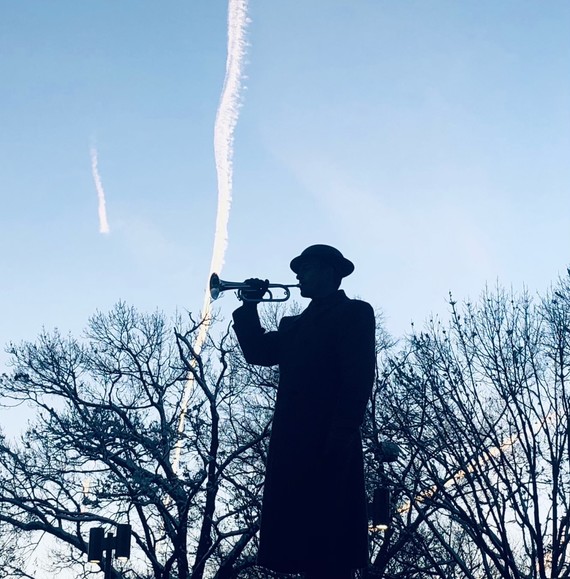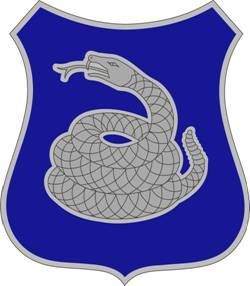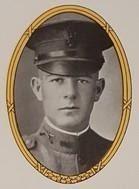|
|
|
|
February 2022
 Sponsored by The Doughboy Foundation, a bugler in World War I uniform sounds Taps every evening at 5 p.m., seven days a week, rain or shine, at the National World War I Memorial in Washington, DC. Planning is in progress for a live stream of Daily Taps on YouTube, with the ability to honor specific veterans, groups or organizations for that day, week, or month. Click on this image to learn more, and find out how you can support this effort, and help ensure that this daily tradition will continue at the National World War I Memorial in perpetuity.
|
|
Contrasting lives: WWI Black Veterans Everett Johnson and Robert Chase
Unconventional Memorials Created by the Forgotten Female Veterans of World War I
Call for Papers: “Lesser-Known Stories
of the Great War: Women, Minorities, Civilians, and the Untold”

This symposium, hosted by the First Division Museum and sponsored by The
Great War Institute at Park University will be held May 13-14, 2022, at the First Division Museum, 1s151 Winfield Road, Wheaton, IL., 60189. Paper and panel proposals in all fields of history related to “Lesser-Known Stories of the Great War: Women, Minorities, Civilians, and the Untold” are invited. The symposium is particularly interested in proposals for complete sessions, including panelists, chairs, and commentators. All proposals should be submitted no later than March 1, 2022. The symposium encourages aspiring and young historians, including graduate students, to present their work. For questions about submitting a proposal, please contact us at gsrcentre@park.edu.
|

Orange County Historian Johanna Yaun will host a trip to Belgium and France next year to honor the soldiers who served in the 369th New York Infantry Regiment. The trip will take place from July 10 -19, 2023 and will explore locations that served as notable backdrops during World War I. Harlem’s Rattlers, the 369th New York Infantry Regiment, later nicknamed the Harlem Hellfighters, was a regiment of soldiers of African American descent from New York City, the Hudson Valley and other parts of the county. Click here to read more, and find out how you can join this limited-space tour to sites of significance related to the 369th.
|

In 2021, Arlington National Cemetery (ANC) served as the designated government leader of the Tomb of the Unknown Soldier Centennial Commemoration, recognizing the 100th anniversary of the Tomb’s creation at ANC on November 11, 1921. The ANC team produced a wealth of content for the public about the history and meanings of the Tomb of the Unknown Soldier, much of which focused on World War I, which will be shared with Dispatch readers in the coming months. Click here to read more, and learn about ANC's amazing Commemorative Guide to the Tomb of the Unknown Soldier.
|

A man is only missing if he is forgotten.
Our Doughboy MIA this month is1st LT Leonard Charles Aitken.
Born in Reno, Nevada on 10 June 1897, Leonard Aitken grew up in California, where he joined the California National Guard at 18 years of age. When the trouble broke out with Mexico, he reported for duty in June 1916 and served along the border with the hospital corps, attending elements of what would, a year later, become the 160th Infantry, 40th Division. Following America’s declaration of war on Germany, on 7 April 1917, Aitken reported to the Officers Training School at San Diego and upon graduation was shipped to France in August 1918 as a 2nd lieutenant with the 158th Infantry, 40th Division. There, on 20 October 1918, he was sent as a replacement officer to the 372nd Infantry, 93rd Division, then holding a section of the line in the Alsace sector near Hill 607. On 7 November, while leading his platoon on a night action, Aitkens and his men captured several prisoners but unknowingly walked into the line of fire of a German machine gun nest, which opened up on them, killing or capturing all but two enlisted men of the patrol and freeing the prisoners. Without hesitation Lieutenant Aitken immediately advanced against the position with the intent of eliminating it, but he was shot twice in the chest and killed in the endeavor. The end result was that they captured 1 officer (Aitkens) and 22 men; however, the date of Aitkens’ death is given as 8 November 1918.
Following the Armistice, Graves Registration Service (GRS) officials went on the search for Aitkens’ remains, but had little luck. Their hardest clue was a report that German officers had buried Aitkens with full military honors “in the church yard of the tiny hamlet of La Paive, some 40 miles east of Epinal, France.” There being no town by that name anywhere in that area, this was almost certainly actually the town of La Pariee which is indeed in the area of the action of 7 November. Nothing was ever found however, and his remains continued to be unlocated in the years following the war. As investigations continued, in January 1924, GRS sent a letter to Aitkens’ father requesting a civilian dental chart, but also admitting in the letter that in all probability he was among the Unknown burials, though how this information was considered is not stated in his surviving file. A final attempt at some kind of identification came in December 1926 when the case files of Aitkens and one other officer from the 372nd Infantry were checked against a set of Unknown remains at the Meuse-Argonne Cemetery morgue. It was a long shot, however, as the remains being checked came from a French cemetery in the Marne sector some 300 kilometers northwest of where both officers in question were at the time of their deaths. Not surprisingly, neither officer’s remains were a match and Aitkens’ case was officially closed in 1932 without resolution.
Would you like to help solve Lt. Aitken’s case? Please consider a donation to Doughboy MIA and help us make as full an accounting of our American service personnel still listed as missing in action from WW1 as possible. Can you spare just ten dollars? Give 'Ten For Them' to Doughboy MIA and help us make a full accounting of the 4,423 American service personnel still listed as missing in action from WW1. Make your tax deductible donation now, with our thanks.
|
Merchandise from the Official
Doughboy Foundation WWI Store
 Lest We Forget: The Great War World War I Prints from the Pritzker Military Museum & Library. One of the nation’s premier military history institutions pays tribute to the Americans who served and the allies they fought beside to defeat a resourceful enemy with a lavishly illustrated book. It is an official product of the United States World War One Centennial Commission and is a tribute to those who served in the Army, Navy, Marine Corps, and what would become the Air Force. It serves as a lasting reminder that our world ignores the history of World War I (and the ensuing WWII) at its peril―lest we forget.
Honoring the Doughboys: Following My Grandfather's World War I Diary is a stunning presentation of contemporary photographs taken by the author that are paired with diary entries written by his grandfather, George A. Carlson, who was a soldier in the U.S. Army during World War I. Jeff Lowdermilk followed his grandfather's path through France, Belgium, Luxembourg, and Germany and returned with these meticulously crafted photographs and his own engaging stories that bring the diary to life for contemporary readers. Lowdermilk's passion for World War I and military history began as a young boy when he listened to his grandfather tell his stories about serving as an infantryman-- a "Doughboy"--in Europe during the Great War.
Proceeds from the sale of these books will help finish the new National World War I Memorial in Washington, DC.
This and many other items are available as Official Merchandise of the Doughboy Foundation.
|
|
|
|

Submitted by: Johnette Brooks {granddaughter}
Sgt Henry Veal, II served in World War 1 with the United States Army . The dates of service are: Known 30 APR 1918 - 30 AUG 1918.
Story of Service
18 FEB 1895, Henry was born in the Spring Hill District 2 of Milledgeville, GA. He was the baby son of eleven (11) children of Henry Veal, I and Lucy Ann Hearst of Deepstep, GA. Henry, II’s father was a minister and a farmer. Henry, II (Sr.) grew up a few doors down from his future bride, Mamie Solomon on the highway that would later (13 AUG 2011) be named in their honor.
He joined Green Pastures Baptist Church as a youth and attended school until the 5th Grad . On 5 JUN 1917, Henry registered for the WWI Draft.
He was inducted in Milledgeville GA on 29 APR 1918 and was entrained on 30 APR at Camp Gordon in the 157th Depot Brigade until September 21, 1918. he departed Newport News VA on the USS Mercury headed for Brest, France.
Seven (7) days after boarding the ship, he was promoted to Sgt. on 21 OCT 1918 and then Mess Sergeant to the White Officers on the same day. He served overseas in France from 13 Oct 1918 to 13 AUG 1919 and was honorably discharged from the Army on August 30, 1919. He was reduced back to the rank of Private on 27 FEB 1919 while still serving in France, likely to avoid paying the Sergeant's pension upon his discharge. Seven (7) days after returning from France, he received his final Army payment of $4,278.95.
|

|
|
|
|